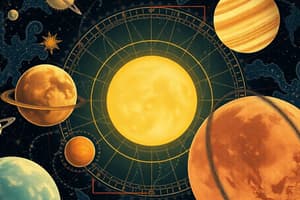Podcast
Questions and Answers
The universe may have begun 13.8 billion years ago from a single point called ______.
The universe may have begun 13.8 billion years ago from a single point called ______.
singularity
The Nebular Hypothesis states that the solar system may have begun 4.54 billion years ago in a cold spinning cloud of solar ______.
The Nebular Hypothesis states that the solar system may have begun 4.54 billion years ago in a cold spinning cloud of solar ______.
nebula
As matter collects at the center of the nebula, it forms a hot gas ball known as a ______.
As matter collects at the center of the nebula, it forms a hot gas ball known as a ______.
protostar
Mercury is classified as a ______ planet with a solid and cratered surface.
Mercury is classified as a ______ planet with a solid and cratered surface.
Earth's surface is covered in water and has a perfect balance in its ______ for living organisms.
Earth's surface is covered in water and has a perfect balance in its ______ for living organisms.
Mars has a thin atmosphere made up of a small amount of oxygen and ______ vapor.
Mars has a thin atmosphere made up of a small amount of oxygen and ______ vapor.
Jupiter, the biggest planet in our solar system, is primarily composed of ______.
Jupiter, the biggest planet in our solar system, is primarily composed of ______.
Saturn is classified as a ______-giant planet and does not have a solid surface.
Saturn is classified as a ______-giant planet and does not have a solid surface.
The surface temperature of Venus is hot enough to melt ______.
The surface temperature of Venus is hot enough to melt ______.
Earth is characterized by a dynamic surface that includes mountains, canyons, and ______.
Earth is characterized by a dynamic surface that includes mountains, canyons, and ______.
Flashcards are hidden until you start studying
Study Notes
Characteristics of Uranus and Neptune
- Composed of icy materials: water, methane, ammonia above a rocky core.
- Atmospheres primarily consist of molecular hydrogen and atomic helium, with minor methane.
Classification of Planets
- Terrestrial/Rocky Planets: Mercury, Venus, Earth, Mars.
- Gaseous/Jovian Planets: Jupiter, Saturn, Uranus, Neptune.
Unique Features of Earth
- Known as the “Goldilocks Planet” due to its ideal distance from the Sun, enabling the existence of liquid water.
- Only planet in the Solar System with liquid water on the surface; life is confined to temperatures between -15°C and 115°C.
Earth's Atmosphere
- Maintains warmth, supplies essential chemicals (nitrogen, carbon dioxide, oxygen), and shields from harmful radiation and meteorites.
Energy Sources
- Continuous supply of light energy and energy-rich chemicals enables crucial chemical reactions necessary for life.
Nutrient Circulation
- Mechanisms like the water cycle, atmosphere dynamics, and volcanic activity facilitate nutrient distribution.
Earth's Subsystems
Geosphere
- Comprises multiple layers of land, with the uppermost layer rich in nutrients, oxygen, and silicon.
Hydrosphere
- Encompasses all water forms: solid, liquid, gas. Approximately 97% of Earth's water is saline, primarily found in oceans.
Biosphere
- Incorporates all living entities including microorganisms, plants, and animals.
Atmosphere
- Air in Earth's system composed of gases in varying proportions: nitrogen (78%), oxygen (21%), argon (0.9%), traces of carbon dioxide, nitrous oxides, methane, and ozone.
Water Cycle
- Global cycle involving evaporation, sublimation, transpiration, condensation, and precipitation.
- Surface runoff occurs when precipitation flows over land; groundwater is water absorbed by the ground.
Rock Cycle
- Process responsible for the degradation, sculpting, and transformation of rocks in Earth's crust.
Theories of Cosmic Formation
Big Bang Theory
- Proposes the universe began approximately 13.8 billion years ago from a singularity in a violent explosion, leading to gradual expansion.
Nebular Hypothesis
- Most accepted theory for solar system formation, starting around 4.54 billion years ago from a cold, spinning solar nebula.
- Gravitational forces caused material to condense, forming a protostar (the Sun) and leading to planet formation from clumps of dust.
Overview of Solar System Planets
- Mercury: Terrestrial planet with a cratered surface; thin atmosphere comprised of oxygen, sodium, hydrogen, helium, potassium.
- Venus: Solid surface with volcanic features; extreme temperatures capable of melting lead.
- Earth: Dynamic rocky planet with extensive water coverage; balanced atmosphere for sustaining life.
- Mars: Rocky planet showing signs of volcanic activity; has a thin atmosphere with minimal oxygen and water vapor.
- Jupiter: Largest planet, primarily gaseous, with hydrogen and helium as dominant elements.
- Saturn: Gas giant without a solid surface; potential solid core may exist within its gaseous layers.
Studying That Suits You
Use AI to generate personalized quizzes and flashcards to suit your learning preferences.




